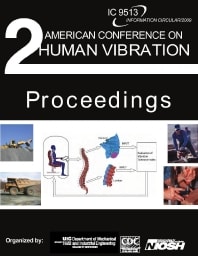Mining Publication: Proceedings of the Second American Conference on Human Vibration
Original creation date: June 2009
Authors: F Amirouche, AG Mayton
NIOSHTIC2 Number: 20035826
Pittsburgh, PA: U.S. Department of Health and Human Services, Public Health Service, Centers for Disease Control and Prevention, National Institute for Occupational Safety and Health, DHHS (NIOSH) Publication No. 2008-123, Information Circular 9513, 2009 June; :1-137
There is a saying, "If it moves, it vibrates." This is especially true in our modern industrial environments, where workers use powered tools, machinery, vehicles, and heavy equipment. How workers are affected by these elements of the industrial working environment is a concern of health professionals, governments, and scientists around the world. How to adequately assess the effects of human vibration exposure is an equally important issue. The human body comprises a dynamic structure that is living, intelligent, and complex. Consequently, it is not unreasonable to consider that exposing the body to an array of vibration environments would result in outcomes that are not necessarily simple or easily predictable. Sensations caused by vibration may include nausea, annoyance, discomfort or pain, and exhilaration or pleasure. Many factors contribute to the effects of vibration on humans, including the characteristics of the motion and the exposed individual, the activities of the exposed individual, and various elements of the environment. There have been attempts to summarize the effects of occupational vibration exposures by simply recommending the avoidance of certain frequencies of vibration or by providing a graphical method, i.e., a single curve displaying all human responses to all frequencies. However, such efforts have not withstood the scrutiny of scientific research and analysis. Thus, attendees and participants at this professional gathering now have the rare opportunity to benefit from the technological advances and new scientific research to enhance their understanding of human responses to vibration that suggest more than a simplistic approach. In the tradition of the First American Conference on Human Vibration (1st ACHV) held in Morgantown, WV, June 2006, the 2nd ACHV provides a forum for scientists, engineers, medical doctors, industrial hygienists, and educators to learn and advance research and education in the specialized area of human body vibration. The conference was organized by the Mechanical and Industrial Engineering Department, University of Illinois at Chicago, with support from the National Institute for Occupational Safety and Health (NIOSH), Pittsburgh Research Laboratory. As with the first conference, the 2nd ACHV provides the unique opportunity to learn about the current activities of peers and colleagues and to exchange information on topics of interest such as human response, human modeling, experimental design, sensors, new technologies, and epidemiological studies of human responses to hand-transmitted and whole-body vibration. The conference organizers hope that the publication of these conference proceedings continues to foster new research and technological advances to reduce health hazards associated with occupational vibration exposures.

NIOSHTIC2 Number: 20035826
Pittsburgh, PA: U.S. Department of Health and Human Services, Public Health Service, Centers for Disease Control and Prevention, National Institute for Occupational Safety and Health, DHHS (NIOSH) Publication No. 2008-123, Information Circular 9513, 2009 June; :1-137